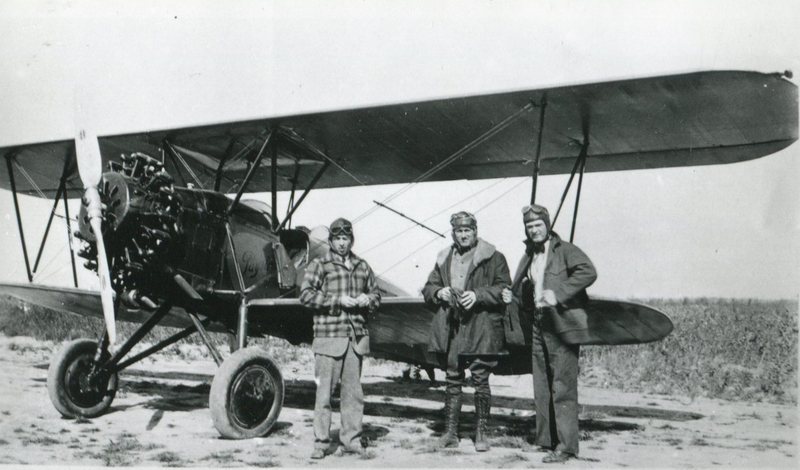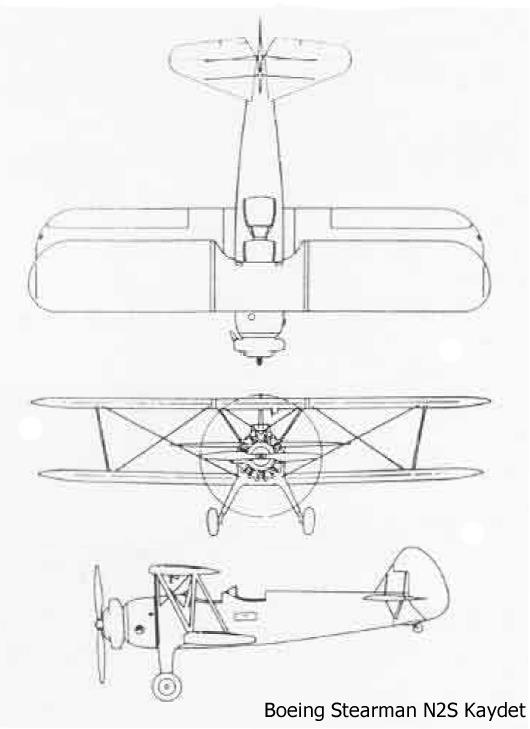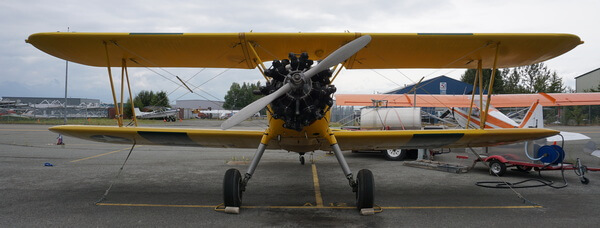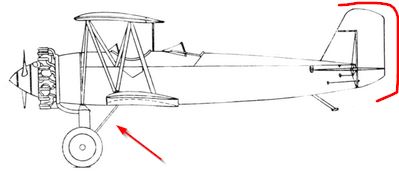warplane.com ca - Boeing PT-17 Stearman
| Stearman Home >> | Stearman vs Boeing |

A little history of the Stearman aircraft, model C2B. The first of these aircraft came off the assembly line in Wichita, Kansas in January of 1928. Over the years this model flourished and with changes from time to time was used for many purposes. In the 1930’s and 40’s nearly 10 thousand were built and used by the military to train pilots. In that mode it was designated the PT-17 (Primary trainer). Following WWII, many were converted for use in agriculture as crop dusters which required an engine with far more horsepower.



Three-view drawing of the Boeing Stearman Model 75 Kaydet.
(USAAF PT-13/-17/-18/-27, USN N2S)
Stearman C2B
| Model: | C2B → C3B | 75 → N2S | ||
|---|---|---|---|---|
| Length: | 24 ft | 7.32 m | 24 ft 9 in | 7.54 m |
| Wingspan Upper: | 35 ft | 10.66 m | 32 ft 2 in | 9.80 m |
| Wingspan Lower: | 28 ft | 8.53 m | 31 ft 2 in | x10.66 m |
| Height: | 9 ft | 2.75 m | 9 ft 8 in | 2.95 m |
| Empty Weight: | 1,650 lb | 748 kg | 1,931 lb | 876 kg |
| Gross weight: | 2,650 lb | 1,202 kg | 2,635 lb | 1,195 kg |
| Fuel capacity: | ?? Gal | ?? L | 46 US Gal | 170 L |
| Powerplant: | Wright J-5 | Continental R-670 Lycoming R-680 |
||
| 220 hp | 164 kW | 220 hp | 164 kW | |
| Performance | ||||
| Max Speed: | 126 mph | 204 km/h | 124 mph | 200 km/h |
| Cruise Speed: | 108 mph | 175 km/h | 96 mph | 154 km/h |
| Range: | 620 miles | 1,004 km | ||
| Ceiling: | 13,200 ft | 4,000 m | ||
 |
C3B - Top wing overhangs the lower wing by 3.5 feet There is a strut that goes from the main wheel axle to the centerline of the fuselage |
 |
Kaydet - Top wing is only slightly longer than the lower wing Single massive strut from the wheel to the fuselage |
 |
C3B - Landing gear struts above and below the fuselage Relatively squared off tail, flat at the back |
 |
C3B - Landing gear has 6 struts per side plus flying wires going to the outboard wing struts |
 |
Kaydet - Single massive strut from the wheel to the fuselage Rounded off tail |
 |
C3B - Different length wings Top wing center section is straight, can't see front cockpit Rounded horizontal tail section, no brace wire |
 |
Kaydet - Same length wings Top wing center section is cut out, can see front cockpit Longer horizontal tail section straight leading edge, two brace wires |
Stearman Production Numbers
The Alaska Aviation Museum has an early model Stearman. It started as a C2-B with a Wright J-4 engine. It was converted to a C3-B with a Wright J-5 engine. There were only a few hundred of the early model airplanes made.
In 1934, Stearman became part of Boeing. The Model 75 “Kaydet” came out. It had lots of other model numbers along the lines of alphabetic character 75, or alphabetic character 75N1, or PT-17, or PT-13. It was a primary trainer for the Army and Navy in World War II, over 10,000 were built. There is about a 97% chance that when there is a reference to a "Stearman", they are referring to a 1930s or 1940s Boeing built plane.
That ratio is reflected in the numbers of the models that are still registered with the FAA.
Stearman Production
| Model | Date | Production | Comments |
|---|---|---|---|
| C1 C2 |
1926 Oct | 4 | Stearman Aircraft Corporation founded in Venice, California |
| 1927 Sep | A new Stearman Aircraft Corporation was created in Wichita, Kansas | ||
| C2B | 1928 Apr | AAM Stearman N5415 - Build date: 4/11/1928 Serial Number 121 With a Wright J-4-B engine | |
| C2s | 1929 | 133 | |
| C3B | ≈116 | Introduced in 1928, C3B Sport Commercial 220 hp (164 kW) Wright J5 radial engine. | |
| 1929 | Sold the company to the United Aircraft and Transport Corporation. | ||
| C4 | 1929 | ≈41 | Speedmail Model in Wichita, Kansas from September 1929 to August 1930. |
| C3Rs | 1931 | ≈39 | Last of the C3Rs built in Oct 1931 |
| 1934 Sep | Federal anti-trust legislation broke up the United Aircraft and Transport Corporation. Boeing became a separate business. Stearman was made a subsidiary. |
||
| 75 | 1934+ | ≈10,620 | Stearman (Boeing) Model 75 Kaydet The “Kaydet” would become the primary trainer aircraft for the United States military during World War II. |
FAA Registry Stearman C3-B as of 2019/06/26
| Ser# | N-Nbr | Date | Owner | City | State | Engine |
|---|---|---|---|---|---|---|
| 104 | N3440 | 1927 | Western Antique Aeroplane & Automobile Museum | Hood River | OR | P&W R-985 |
| 121 | N5415 | 1928 | Alaska Aviation Museum | Anchorage | AK | Wright J-5 |
| 166 | N5095M | Museum Of Flight Foundation | Seattle | WA | ||
| 169 | N6438 | Yellowstone Aviation Inc | Jackson | WY | Wright J-5 | |
| 192 | N6494 | Gregersen Scott T | Pocatello | ID | ||
| 204 | N9067 | Kansas Aviation Museum | Wichita | KS | ||
| 207 | N6496 | 1928 | Williams C M | Kennesaw | GA | Cont Motors W670 |
| 221 | N8811 | 1929 | Alfred And Lois Kelch Aviation Museum Inc | Brodhead | WI | Wright J-5 |
| 241 | N8835 | 1928 | George Mike | Springfield | IL | Cont Motors W670 |
| 244 | N8830 | 1928 | Western Antique Aeroplane & Automobile Museum | Hood River | OR |
- - -
FAA Registry Boeing 'A75' as of 2019/06/26
| Model | Number |
|---|---|
| A75 | 92 |
| A75L3 | 35 |
| A75L300 | 33 |
| A75N1 | 60 |
| A75N1(PT17) | 796 |
| B75 | 16 |
| B75N1 | 238 |
| D75N1 | 41 |
| E75 | 273 |
| E75N1 | 81 |
| Total: | 1,665 |

From the left rear quarter, we can see that the fuselage is flat sided,
There is a foot well and an external foot step to get into the pilot's cockpit.
Watch out for the brace wire when getting into the front cockpit.
There is a small baggage compartment built into the side of the fuselage in back of the pilot.

The upper wing is further forward and cut out over the front cockpit
No foot well or external foot step to get into the pilot's cockpit.
Brace wire is well forward for getting into the front cockpit.
There is a large baggage compartment built into the top of the fuselage in back of the pilot.
.jpg)
This is a late model Stearman. Notice the round fuselage and the single large strut going down to the wheel.